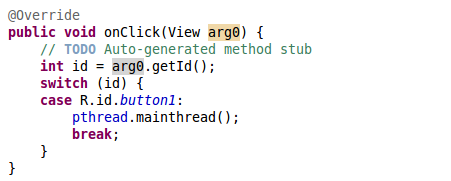
- Android ndk pthread how to#
- Android ndk pthread serial#
- Android ndk pthread android#
- Android ndk pthread software#
- Android ndk pthread code#
Android ndk pthread serial#
One button initiates parallel processing of the set, the other initiates serial processing. This example comes with a fairly simple RelativeLayout set up with two buttons, one TextView and one ImageView. What better way to do this than by breaking up generating a pretty picture of the Mandelbrot set into one thread per core available in the system, passing the buffer between Dalvik and Native?

I also wanted to show that the basic Pthread calls work as expected, and give a small hint of what non-obvious requirements a JNI interface imposes on C code.
Android ndk pthread code#
In this example I wanted to include enough processing to show any difference in performance between a single and multiple threads, without making the code itself very complex. You can find which libraries are supported by looking into your NDK installation directory - under platforms/android-/arch-arm/usr/lib. This does however mean that many useful libraries that are available in your system cannot trivially be linked against by your native code (one example is libjpeg). The NDK includes a minimal set of common libraries guaranteed to be available on all devices supporting this version of the NDK. The ADT also has a "logcat" output tab which can be enabled through Window->Show View->Other.->Android->LogCat.
Android ndk pthread android#
Android applications log output through the logcat facility, which provides a printf-style logging facility not entirely unlike UNIX syslog. If you want some debug output from your program, printf is not your ally here. However, all of the common Pthread APIs make use of kernel helper functions for things like atomic updates, which means that mutexes and semaphores will still correctly use memory barriers where required. This means that using it on certain multi-core systems might not be supported, depending on its exact CPU architecture. There is a very scary statement in there:Īt the moment, Bionic does not provide or use read/write memory barriers. So in short, if it is declared in pthread.h or semaphore.h, it will mostly work as expected.Īlso included in the NDK documentation is an overview of the Bionic library:ĭocs/system/libc/OVERVIEW.html. What is not implemented however is SysV IPC - Google dedicate an entire text file in the NDK documentation to discussing the rationale for this:ĭocs/system/libc/SYSV-IPC.html. It does explicitly exclude the pthread_cancel() function, but apart from that most of the pthread_* and sem_* functions are implemented. The Bionic C library implements a version of the Pthreads API. class file, which takes it from whatever functions have been declared as native in the corresponding. The javah command extracts this from the specified. For the attached example, the command line javah -jni workspace/ndkmc/bin/.ndkmcpkg.ndkmcact is used to generate an include (.h) file with the correct function prototypes from the Java class. This includes the naming standard (similar to C++ name mangling) used to connect your native code to a specific Java class. This defines how Java and Native code can call each other. Native code in an Android app integrates with the Dalvik VM (even if it is a native activity - it is just more hidden from you then) using the Java Native Interface (JNI). If this sounds interesting, do look at Google's documentation of the Native Activity class, which contains quite comprehensive example code.


Android ndk pthread software#
The Native Activity approach is certainly very useful for developers of cross-platform applications, as it greatly reduces the thickness of the required Android-specific software layer. Creating a Native Activity, and rendering your own UI using OpenGL ES.īecause the amount of OpenGL ES boilerplate required for using exclusively native code would have somewhat overshadowed the example code, a mixed Dalvik/Native solution was used instead.Using the Dalvik runtime environment to present a UI to the user and capturing events, but performing parts (or all) of the program logic in native code.When developing natively for Android, there are two possible ways to do this: Building the example also requires the Android SDK and the Eclipse ADT plug-in to be installed. The example has been developed using NDK version 5c, released in June 2011.
Android ndk pthread how to#
This post assumes that you have the NDK downloaded and installed as per these instructions, with the "ndk-build" command available on your PATH (or know how to translate the instructions below to specify an absolute path).

Segmented Text Toggle Button for Androidįinally a look at what options are available to us when developing in C/C++ or assembly language.Ĭ/C++ development of Android apps is done using the Native Development Kit, or NDK.


 0 kommentar(er)
0 kommentar(er)
